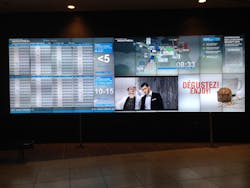Airport Technology: Building the Customer Experience, Concessions & Retail, Going Green
With technology continually improving, one of the best ways to apply it is in ways that make our lives easier. Certainly, that’s often the goal with most technologies, yet with travel often being one of the most stressful experiences for people, streamlining the process is ever so important.
One way to simplify this process is through digital signage. By utilizing digital signage, airports can reduce perceived wait times, utilize wait times to share information and ease travel stress with directional signage and trip updates, all of which contribute to increased customer satisfaction.
Moreover, beyond the traditional uses of digital signage for travel updates, signage technology in airports can be used not only to garner advertising revenue, but at a minimum, also enhance concession and retail shopping experiences.
Building the Customer Experience: Communication and Accessibility
The entryways to airports tend to be the heaviest areas of traffic. These locations are where guests check in and out, where they enter and exit the airport, and oftentimes, where they meet their friends, family and co-workers. Therefore, these ingresses are the perfect places to share pertinent information. However, with so much activity concentrated at these points it can also be difficult to get travelers’ attention. However, through eye-catching displays and consistently changing content digital signage provides travelers with up-to-date travel information for a seamless experience. Displays can also be used to provide ticketing, navigation, emergency alerts, and entertainment.
Additionally, by implementing way-finding and self-service kiosks, travelers can check themselves in, print tickets, locate facilities and much more. These kiosks also enhance the customer experience, reduce staffing costs and more efficiently utilize resources.
In addition to digital signage and AV technology, airports can offer greater convenience to travelers by focusing on mobility. By developing an app or incorporating mobile integration, the convenience factor is even more prevalent and valuable to the traveler, especially at airports. Through mobile integration, benefits like checking in and out, checking flight information, submitting a cancellation and requesting services are readily available - faster – giving the traveler better control of their own experience.
ADA Compliance
In 1990, the Americans with Disabilities Act (ADA) was signed into law to prohibit discrimination and ensure equal access and opportunity for those with mental and physical disabilities in the areas of employment, public entities, public accommodations, commercial facilities, telecommunications and more.
In 2010, additional provisional regulations were signed into effect to revise the area of Accessible Design, enhancing the lifestyles of the over 54 million disabled Americans. These regulations ensure that public spaces have, among other accessibility features, clear pathways and curbed ramps.
For airports, this law affects the planning of many digital signage applications including kiosks that sell tickets and video wall displays, among others. For example, video walls that are between 27″ and 80″ off the floor must be less than 4″ off the walk to allow for the visually impaired to easily walk past.
In the past with large and bulky displays, ensuring compliance in this area was a bit more complicated. Most often, this required integrators to recess displays into the wall, which took more time and was often more complicated and expensive. Now, displays are getting slimmer and lighter, which helps to accommodate this requirement.
ADA regulations also apply to the construction and functionality of digital signage kiosks. For example, if your device has touch features, the maximum height off the ground is 48″, with a max reach of 10″. A reach larger than this requires a shorter kiosk.
With enhanced technology, integrating ADA compliant kiosks has become easier. Advanced IR sensors are used to determine height and cater the placement of touch capabilities on displays in accordance with ADA regulations.
A multitude of additional options exist for compliance in digital signage, including voice responsive software, Braille keyboards, and tactile signs.
By making all signage engaging and accessible, each and every traveler can be the beneficiary of new technologies.
Concessions: Menu Board Benefits
In addition to making the traveler more informed, digital signage offers a multitude of benefits for concession stands in airports, particularly when compared to the static signage used by a large portion of food stands today.
- Flexibility: Digital menu boards offer the flexibility needed to update content instantly and remotely. (e.g., Promo items and menu content including new items, prices, sold-out items, calorie counts, etc.). This ability smoothly accommodates day-parting, the ability to change the breakfast menu to feature the lunch menu – from a remote computer.
- Increase in sales: Animated menu content is more eye-catching than static signage, which further entices customers to make additional purchases. This too offers concession stands the chance to visually promote new, healthier options.
- Decrease in operational costs: No need to regularly pay to update the signage due to wear and tear, or for updates on the menu items, nutritional details, promos, etc.
Most importantly, new digital menu boards offer the opportunity to feature nutrition details, a great solution for frequent travelers who are trying to maintain a healthy lifestyle and/or those with food sensitivities. Individuals will no longer need to avoid restaurants or food providers with foods they feel are “bad,” while they look to reduce calorie, carbohydrate, and/or fat intake, depending on their dietary needs and health goals. The ability to have this information while on-the-go is a great way to attract business from these health-minded travelers.
By offering nutrition information in an engaging way, concession stands at airports can:
- Create food awareness, allowing customers to feel confident in what they are purchasing by making an informed choice.
- Help customers to make purchases based on the quality of food over quantity or price.
- Increase customers’ chances of weight loss success as visually seeing calorie counts helps individuals maintain mindfulness of their dieting goals.
By offering further nutrition information to customers in an engaging way, both the customer and airport concessions can indeed see benefits.
Retail Digital Signage
As with the aforementioned, utilizing digital signage in retail shops throughout the airport too offers vast benefits:
- Stock levels: Airport retailers can utilize kiosks to offer digital customer service. Offering in-store kiosks allows customers to search inventory online for out of stock items. By offering free standard shipping for orders placed at these kiosks, retailers can negate lost sales due to sold-out items. Kiosks can also be used to print out coupons for these items to be purchased at a later date when the individual is traveling again.
- Sales: Inside the store, digital signage can be used to feature videos and/or stills suggesting some of the very best items or deals to help generate sales. Signage here helps consumers come up with gift ideas and informs them of sales and promotions. The signage can also benefit the retailer. For example, retailers can look to supplier-sponsors to offset some digital signage maintenance costs.
- Modeling: New large-scale displays are changing the retail landscape as a whole. Travelers who wish to purchase clothing at the airport no longer have to simply wonder how something will look on them. Large format displays now allow individuals to see clothing on life-size models who appear nearly 3D on 4K screens. Prior to these large screens, retailers would have to utilize a combination of smaller screens to try to achieve this experience, though not seamless due to divisions created by bezels. When used in store windows, these large screens allow retailers to forgo the lengthy process of changing window displays. Additionally, content can quickly be updated with new sales or models’ attire can be tailored to the current weather conditions or even for the weather conditions for nearby flights’ destinations.
Going Green and Reducing Costs
The pressure to reduce both costs and go green can be quite substantial for airports. But, where can airports afford to cut corners? The real answer is nowhere. However, with some strategic decision-making, there is money to be saved in operational costs.
There are many variables to be considered when analyzing possible operational costs reductions in digital signage. For example, purchasing cheaper quality screens can hurt both the traveler’s experience and the airport. If airports anticipate signage to last for three years, there are clear considerations such as upfront pricing, the cost of service, maintenance, and software updates. Cutting corners on screens or any of the hardware can certainly cost airports more in the long run.
Though it may not readily strike airports as an operational concern, location can also impact ongoing support costs. Where will the display be located? How high is it? How easy is it to access the signage? Can it be accessed and updated remotely? The answers to these questions affect operational costs. Even so, in terms of functionality and return on objective (ROO), access to a display can often make or break a digital signage installation, particularly if corners are cut upfront. For example, “secure” airport locations may not be quickly and easily accessed for service.
There are smart choices that can be made with indoor digital signage to reduce operational costs related to energy consumption. This lies in the choice between the LCD and LED display. LCD displays, which utilize the light modulating properties of crystals, do indeed use less energy than traditional tube displays. However, by moving to LED displays rather than LCD displays, airports can find anywhere from a 30%-60% reduction in energy and power consumption. This can be a huge savings for applications with multiple displays, particularly those that must run continuously. Use of LED displays can also be incorporated into energy efficient and green certified buildings.
Beyond selecting solid hardware that may reduce energy consumption, the way to reduce maintenance costs is quite simple: perform maintenance. A proper service package/regimen is the best way to reduce costly malfunctions. A remote monitoring system can keep an eye on signage, while negating the cost of the man-hours needed to physically come out to check on displays. By simply plugging the device into a display, airports can remotely check if the display turned on and off when it was supposed to, amongst other items, and the system will alert airports when something goes wrong. For example, through a monitoring system’s power cycle, each display in a network can be checked to ensure that it is up and running. If it cannot be found, an email will be sent. Knowing something is wrong before the traveler does is the best-case scenario for all parties involved.
Once the aforementioned have been considered, the true takeaway here is that the opportunities for functions of digital signage in airports are endless.
Digital signage can be used to generate revenue through advertising, provide personalized guest service and way-finding, communicate with travelers, enhance shopping and dining experiences, and more.
With visual solutions, we can create a 360-degree travel experience, allowing customers to interact with transit providers anywhere, at any time of day.
A constant stream of fresh content on-demand is the expectation these days and it is through digital signage that airports can truly accomplish superb communication.
Peerless-AV is a member of the Digital Signage Federation, the only independent, not-for-profit trade organization serving the digital signage industry. The DSF supports and promotes the common business interests of worldwide digital signage, interactive technologies and digital out-of-home network industries. To learn more, go to www.digitalsignagefederation.org
As Executive Vice President at Peerless-AV, Nick Belcore is responsible for all Sales and Business Development initiatives generated from the company’s worldwide headquarters. In this role, Belcore oversees the development of strategic business relationships and oversees the Business Development team, which manages global Digital Signage installations and programs for large-scale retail and commercial customers. Belcore also works closely with the Product Management team to ensure the success of each product launch.
Prior to his current position, Belcore served as Vice President of North American Sales, where he led the Sales and Business Development teams responsible for the Americas.
Drawing on more than 17 years of sales and management experience, Belcore has represented products and brands generating revenue in the hundreds of millions of dollars. He has worked with multiple Fortune 500 companies, supporting product launches for several “best in category” products.
A qualified expert on Digital Signage, his team has led merchandising, display and logistical efforts for a number of home center chains, including Wal-Mart, K-Mart, Target, Rite Aid and many others.
Belcore has earned numerous national sales achievement awards for excellence throughout his career and is also a Digital Signage Certified Expert (DSCE). He completed his undergraduate work at Drake University.






